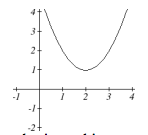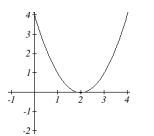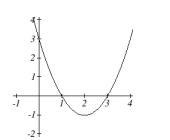Classify Solutions to Quadratic Equations
12.3 Learning Objectives
- Quadratic Equations with Complex Solutions
- Use the quadratic formula to solve quadratic equations with complex solutions
- Connect complex solutions with the graph of a quadratic function that does not cross the x-axis.
- The Discriminant
- Define the discriminant and use it to classify solutions to quadratic equations
[latex]2x^2+3x+6=0[/latex]
Using the Quadratic Formula to solve this equation, we first identify a, b, and c.
[latex]a = 2,b = 3,c = 6[/latex]
We can place a, b and c into the quadratic formula and simplify to get the following result:
[latex]x=-\frac{3}{4}+\frac{\sqrt{-39}}{4}, x=-\frac{3}{4}-\frac{\sqrt{-39}}{4}[/latex]
Up to this point, we would have said that [latex]\sqrt{-39}[/latex] is not defined for real numbers and determine that this equation has no solutions. But, now that we have defined the square root of a negative number, we can also define a solution to this equation as follows.
[latex]x=-\frac{3}{4}+i\frac{\sqrt{39}}{4}, x=-\frac{3}{4}-i\frac{\sqrt{39}}{4}[/latex]
In this section we will practice simplifying and writing solutions to quadratic equations that are complex. We will then present a technique for classifying whether the solution(s) to a quadratic equation will be complex, and how many solutions there will be.
In our first example we will work through the process of solving a quadratic equation with complex solutions. Take note that we be simplifying complex numbers - so if you need a review of how to rewrite the square root of a negative number as an imaginary number, now is a good time.
Example 12.3.1
Use the Quadratic Formula to solve the equation [latex]x^{2}+2x=-5[/latex].Answer: First write the equation in standard form. [latex-display]\begin{array}{r}x^{2}+2x=-5\\x^{2}+2x+5=0\,\,\,\,\,\\\\a=1,b=2,c=5\,\,\,\end{array}[/latex-display] [latex-display] \begin{array}{r}{{x}^{2}}\,\,\,+\,\,\,2x\,\,\,+\,\,\,5\,\,\,=\,\,\,0\\\downarrow\,\,\,\,\,\,\,\,\,\,\,\,\,\,\downarrow\,\,\,\,\,\,\,\,\,\,\,\,\,\,\,\,\downarrow\,\,\,\,\,\,\,\,\,\,\,\,\,\,\,\,\,\,\\a{{x}^{2}}\,\,\,+\,\,\,bx\,\,\,+\,\,\,c\,\,\,=\,\,\,0\end{array}[/latex-display] Substitute the values into the Quadratic Formula. [latex-display] x=\frac{-b\pm \sqrt{{{b}^{2}}-4ac}}{2a}\\x=\frac{-2\pm \sqrt{{{(2)}^{2}}-4(1)(5)}}{2(1)}[/latex-display] Simplify, being careful to get the signs correct. [latex-display] x=\frac{-2\pm \sqrt{4-20}}{2}[/latex-display] Simplify some more. [latex-display] x=\frac{-2\pm \sqrt{-16}}{2}[/latex-display] Simplify the radical, but notice that the number under the radical symbol is negative! The square root of [latex]−16[/latex] is imaginary. [latex] \sqrt{-16}=4i[/latex]. [latex-display] x=\frac{-2\pm 4i}{2}[/latex-display] Separate and simplify to find the solutions to the quadratic equation. [latex-display]\begin{array}{c}x=\frac{-2+4i}{2}=\frac{-1+2i}{1}\cdot \frac{2}{2}=-1+2i\\\\\text{or}\\\\x=\frac{-2-4i}{2}=\frac{-1-2i}{1}\cdot \frac{2}{2}=-1-2i\end{array}[/latex-display]
Answer
[latex-display]x=-1+2i[/latex] or [latex]-1-2i[/latex-display]| [latex]\begin{array}{r}x=-1+2i\\x^{2}+2x=-5\\\left(-1+2i\right)^{2}+2\left(-1+2i\right)=-5\\1-4i+4i^{2}-2+4i=-5\\1-4i+4\left(-1\right)-2+4i=-5\\1-4-2=-5\\-5=-5\end{array}[/latex] | [latex]\begin{array}{r}x=-1-2i\\x^{2}+2x=-5\\\left(-1-2i\right)^{2}+2\left(-1-2i\right)=-5\\1+4i+4i^{2}-2-4i=-5\\1+4i+4\left(-1\right)-2-4i=-5\\1-4-2=-5\\-5=-5\end{array}[/latex] |
Example 12.3.2
Use the quadratic formula to solve [latex]{x}^{2}+x+2=0[/latex].
Answer: First, we identify the coefficients: [latex]a=1,b=1[/latex], and [latex]c=2[/latex]. Substitute these values into the quadratic formula. [latex]\begin{array}{l}x\hfill&=\frac{-b\pm \sqrt{{b}^{2}-4ac}}{2a}\hfill \\\hfill&=\frac{-\left(1\right)\pm \sqrt{{\left(1\right)}^{2}-\left(4\right)\cdot \left(1\right)\cdot \left(2\right)}}{2\cdot 1}\hfill \\\hfill&=\frac{-1\pm \sqrt{1 - 8}}{2}\hfill \\ \hfill&=\frac{-1\pm \sqrt{-7}}{2}\hfill \\\hfill&=\frac{-1\pm i\sqrt{7}}{2}\hfill \end{array}[/latex] Now we can separate the expression [latex]\frac{-1\pm i\sqrt{7}}{2}[/latex] into two solutions: [latex-display]-\frac{1}{2}+\frac{ i\sqrt{7}}{2}[/latex-display] [latex-display]-\frac{1}{2}-\frac{ i\sqrt{7}}{2}[/latex-display] The solutions to the equation are [latex]x=\frac{-1+i\sqrt{7}}{2}[/latex] and [latex]x=\frac{-1-i\sqrt{7}}{2}[/latex] or [latex]x=\frac{-1}{2}+\frac{i\sqrt{7}}{2}[/latex] and [latex]x=\frac{-1}{2}-\frac{i\sqrt{7}}{2}[/latex].
[latex]x^2+2x+3=0[/latex]
The function now looks like the type of quadratic equations we have been solving. In the next example, we will solve this equation, then graph the original function and see that it has no x-intercepts.
Example 12.3.3
Find the x-intercepts of the quadratic function. [latex]f(x)=x^2+2x+3[/latex]Answer: The x-intercepts of the function [latex]f(x)=x^2+2x+3[/latex] are found by setting it equal to zero, and solving for x since the y values of the x-intercepts are zero. First, identify a, b, c. [latex-display]\begin{array}{ccc}x^2+2x+3=0\\a=1,b=2,c=3\end{array}[/latex-display] Substitute these values into the quadratic formula.
[latex]\begin{array}{c}x=\frac{-b\pm \sqrt{{b}^{2}-4ac}}{2a}\\=\frac{-2\pm \sqrt{{2}^{2}-4(1)(3)}}{2(1)}\\=\frac{-2\pm \sqrt{4-12}}{2} \\=\frac{-2\pm \sqrt{-8}}{2}\\\frac{-2\pm 2i\sqrt{2}}{2} \\-1\pm i\sqrt{2}=-1+i\sqrt{2},-1-i\sqrt{2}\end{array}[/latex]
The solutions to this equations are complex, therefore there are no x-intercepts for the function [latex]f(x)=x^2+2x+3[/latex] in the set of real numbers that can be plotted on the Cartesian Coordinate plane. The graph of the function is plotted on the Cartesian Coordinate plane below: Graph of quadratic function with no x-intercepts in the real numbers.
Graph of quadratic function with no x-intercepts in the real numbers.12.3.1 The Discriminant
The quadratic formula not only generates the solutions to a quadratic equation, it tells us about the nature of the solutions. When we consider the discriminant, or the expression under the radical, [latex]{b}^{2}-4ac[/latex], it tells us whether the solutions are real numbers or complex numbers, and how many solutions of each type to expect. The table below relates the value of the discriminant to the solutions of a quadratic equation.| Value of Discriminant | Results |
|---|---|
| [latex]{b}^{2}-4ac=0[/latex] | One repeated rational solution |
| [latex]{b}^{2}-4ac>0[/latex], perfect square | Two rational solutions |
| [latex]{b}^{2}-4ac>0[/latex], not a perfect square | Two irrational solutions |
| [latex]{b}^{2}-4ac<0[/latex] | Two complex solutions |
A General Note: The Discriminant
For [latex]a{x}^{2}+bx+c=0[/latex], where [latex]a[/latex], [latex]b[/latex], and [latex]c[/latex] are real numbers, the discriminant is the expression under the radical in the quadratic formula: [latex]{b}^{2}-4ac[/latex]. It tells us whether the solutions are real numbers or complex numbers and how many solutions of each type to expect.Example 12.3.4
Use the discriminant to find the nature of the solutions to the following quadratic equations:- [latex]{x}^{2}+4x+4=0[/latex]
- [latex]8{x}^{2}+14x+3=0[/latex]
- [latex]3{x}^{2}-5x - 2=0[/latex]
- [latex]3{x}^{2}-10x+15=0[/latex]
Answer: Calculate the discriminant [latex]{b}^{2}-4ac[/latex] for each equation and state the expected type of solutions.
- [latex]{x}^{2}+4x+4=0[/latex][latex]{b}^{2}-4ac={\left(4\right)}^{2}-4\left(1\right)\left(4\right)=0[/latex]. There will be one repeated rational solution.
- [latex]8{x}^{2}+14x+3=0[/latex][latex]{b}^{2}-4ac={\left(14\right)}^{2}-4\left(8\right)\left(3\right)=100[/latex]. As [latex]100[/latex] is a perfect square, there will be two rational solutions.
- [latex]3{x}^{2}-5x - 2=0[/latex][latex]{b}^{2}-4ac={\left(-5\right)}^{2}-4\left(3\right)\left(-2\right)=49[/latex]. As [latex]49[/latex] is a perfect square, there will be two rational solutions.
- [latex]3{x}^{2}-10x+15=0[/latex][latex]{b}^{2}-4ac={\left(-10\right)}^{2}-4\left(3\right)\left(15\right)=-80[/latex]. There will be two complex solutions.
- If [latex]b^{2}-4ac>0[/latex], then the number underneath the radical will be a positive value. You can always find the square root of a positive, so evaluating the Quadratic Formula will result in two real solutions (one by adding the positive square root, and one by subtracting it).
- If [latex]b^{2}-4ac=0[/latex], then you will be taking the square root of 0, which is 0. Since adding and subtracting 0 both give the same result, the "[latex]\pm[/latex]" portion of the formula doesn't matter. There will be one real repeated solution.
- If [latex]b^{2}-4ac<0[/latex], then the number underneath the radical will be a negative value. Since you cannot find the square root of a negative number using real numbers, there are no real solutions. However, you can use imaginary numbers. You will then have two complex solutions, one by adding the imaginary square root and one by subtracting it.
Example 12.3.5
Use the discriminant to determine how many and what kind of solutions the quadratic equation [latex]x^{2}-4x+10=0[/latex] has.Answer: Evaluate [latex]b^{2}-4ac[/latex]. First note that [latex]a=1,b=−4[/latex], and [latex]c=10[/latex]. [latex-display]\begin{array}{c}b^{2}-4ac\\\left(-4\right)^{2}-4\left(1\right)\left(10\right)\end{array}[/latex-display] The result is a negative number. The discriminant is negative, so the quadratic equation has two complex solutions. [latex-display]16–40=−24[/latex-display]
Answer
The quadratic equation [latex]x^{2}-4x+10=0[/latex] has two complex solutions.Example 12.3.6
Use the following graphs of quadratic functions to determine how many and what type of solutions the corresponding quadratic equation [latex]f(x)=0[/latex] will have. Determine whether the discriminant will be greater than, less than, or equal to zero for each. a. b.
b.
 c.
c.

Answer: a. This quadratic function does not touch or cross the x-axis, therefore the corresponding equation [latex]f(x)=0[/latex] will have complex solutions. This implies that [latex]b^{2}-4ac<0[/latex]. b. This quadratic function touches the x-axis exactly once, which implies there is one repeated solution to the equation [latex]f(x)=0[/latex]. We can then say that [latex]b^{2}-4ac=0[/latex] c. In our final graph, the quadratic function crosses the x-axis twice which tells us that there are two real number solutions to the equation [latex]f(x)=0[/latex], and therefore [latex]b^{2}-4ac>0[/latex].
| Discriminant | Number and Type of Solutions | Graph of Quadratic Function |
| [latex]b^{2}-4ac<0[/latex] | two complex solutions | will not cross the x-axis |
| [latex]b^{2}-4ac=0[/latex] | one real repeated solution | will touch x-axis once |
| [latex]b^{2}-4ac>0[/latex] | two real solutions | will cross x-axis twice |
12.3.2 Discriminant Summary
The discriminant of the Quadratic Formula is the quantity under the radical, [latex] {{b}^{2}}-4ac[/latex]. It determines the number and the type of solutions that a quadratic equation has. If the discriminant is positive, there are 2 real solutions. If it is 0, there is 1 real repeated solution. If the discriminant is negative, there are 2 complex solutions (but no real solutions). The discriminant can also tell us about the behavior of the graph of a quadratic function.Summary
Quadratic equations can have complex solutions. Quadratic functions whose graphs do not cross the x-axis will have complex solutions for [latex]f(x)=0[/latex].Licenses & Attributions
CC licensed content, Original
- Revision and Adaptation. Provided by: Lumen Learning License: CC BY: Attribution.
CC licensed content, Shared previously
- Ex: Quadratic Formula - Complex Solutions. Authored by: James Sousa (Mathispower4u.com) . License: CC BY: Attribution.
- College Algebra. Provided by: OpenStax Authored by: Abramson, Jay et al.. Located at: https://cnx.org/contents/[email protected]:1/Preface. License: CC BY: Attribution.
- Ex: The Discriminant. Authored by: James Sousa (Mathispower4u.com) . License: CC BY: Attribution.
- College Algebra. Provided by: OpenStax Authored by: Abramson, Jay et al.. Located at: https://cnx.org/contents/[email protected]:1/Preface. License: CC BY: Attribution.
